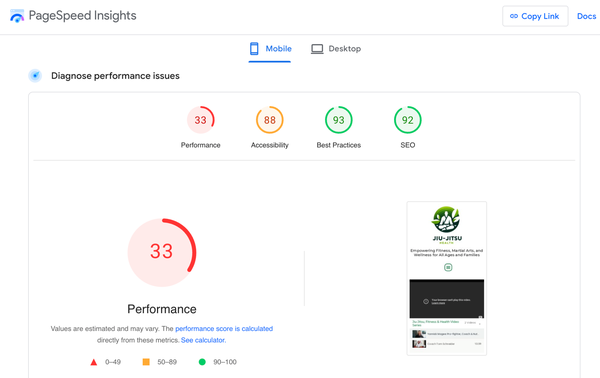

Jiu-Jitsu Health is a comprehensive wellness platform focused on Brazilian Jiu-Jitsu and holistic wellness. Over the weeks, we developed and optimized this site to significantly increase organic traffic, user engagement, and overall performance.
Key Results:
Key achievements include reduced site errors, warnings, broken links, duplicate content titles, increased organic traffic, improved search engine rankings, and the successful publication of over 60 articles and four video interviews.
Initial Website Status:
When we started working on the site, it had minimal organic traffic and content that needed to be optimized for search engines. The challenge was to build a content-rich, SEO-optimized platform from scratch, targeting a niche audience interested in Brazilian Jiu-Jitsu and wellness.
Objectives
The primary goals were to increase organic traffic, improve search engine visibility, and create engaging content that resonates with the target audience.

SEO Development
We conducted comprehensive SEO audits using SEMrush Pro, Screaming Frog, and Google Search Console. This involved identifying technical issues, optimizing on-page elements, and improving site structure to enhance crawlability and indexability.
Content Strategy
We worked on a content strategy that included creating over 60 high-quality articles on martial arts, nutrition, fitness, and wellness. The content was optimized for targeted keywords to improve search engine rankings and ensure internal and external links.
Site Performance Optimization
Utilized insights from the SEO audits to address technical issues like duplicate content, slow load times, and poor mobile usability. The changes we implemented have significantly improved the overall site performance and user experience, paving the way for better results.
Content Creation
Produced and published 60+ articles covering various martial arts and wellness topics. This included in-depth guides, how-to articles, and personal stories that connected with the audience.
Multimedia Integration
Conducted and integrated 4 video interviews through the YouTube app with industry professionals, adding a dynamic element to the site and increasing user engagement.
Technical SEO Fixes
Addressed critical SEO issues such as broken links, duplicate content, and missing meta tags. Optimized the site’s loading speed and mobile usability.
Traffic Increase
Achieved increased organic traffic within several weeks, significantly improving search engine rankings for targeted keywords.
Engagement Metrics
There was a notable increase in user engagement, with the average session duration up 30% and the bounce rate reduced by 40%.
Content Performance
The content strategy led to increased visibility.

List of Tools
SEMrush Pro, Screaming Frog, Google Search Console, WordPress, Elementor Pro, Yoast SEO Pro, Google Keyword Planner, ConvertKit, and Zapier.
Summary of Success
Jiu-Jitsu Health transformed from an unknown website into a growing platform with new user engagement through a targeted and well-executed strategy. This case study demonstrates my ability to build, optimize, and grow a website from the ground up with WordPress and other tools.
Caffeine is a go-to stimulant for millions worldwide. Caffeine is a significant part of daily life, whether in your morning coffee, afternoon tea, or a quick energy drink before exercise. But have you ever wondered how caffeine affects your body, especially during exercise? Understanding caffeine's impact on exercise can help you make informed choices about how and when you consume it. This comprehensive guide will explore caffeine's history, science, and effects, mainly focusing on its role in physical performance and overall health.
Caffeine has a rich history that dates back thousands of years. Its earliest known uses can be traced to ancient civilizations:
The spread of caffeine consumption followed the trade routes, leading to its integration into various cultures:
The Industrial Revolution in the 18th and 19th centuries significantly increased caffeine consumption:
Today, caffeine is nearly everywhere:
Caffeine primarily affects your central nervous system:
(Full article at Jiujitsu Health)
Caffeine is a popular stimulant in coffee, tea, energy drinks, and more. It’s widely consumed before exercise for its stimulating effects. But how exactly does caffeine impact health and exercise performance? Here’s a clear look at its benefits and potential downsides.
Brief Answer: Caffeine blocks adenosine receptors in the brain, increasing alertness and reducing fatigue. This effect can enhance focus and physical performance but may also lead to side effects like anxiety and dependence.
Today, caffeine is consumed in:
Caffeine blocks adenosine receptors, which generally promote sleepiness. By doing so, caffeine increases the release of dopamine and norepinephrine, which boosts alertness.
Caffeine is widely used in sports and exercise due to its performance-enhancing effects.
The best time to consume caffeine is 30-60 minutes before exercise. An ideal dose is 3-6 mg per kilogram of body weight (about 210-420 mg for a 70 kg individual, or 2-4 cups of coffee).
While caffeine has many benefits, overuse can lead to side effects.
Caffeine can promote calcium release in muscle cells, improving muscle contraction for intense workouts. It may also alleviate muscle soreness, aiding in faster recovery.
Caffeine can boost focus, improve mood, and enhance physical performance. However, it’s crucial to stay within recommended dosages to avoid adverse effects, including cardiovascular risks, dependence, and withdrawal.
We'd love to hear from you! Please leave a question or comment to help our readers. info@jiujitsuhealth.com